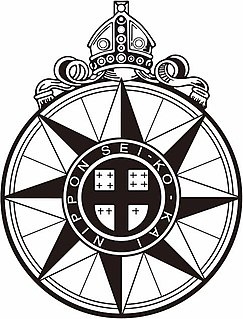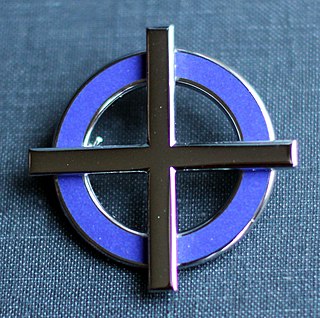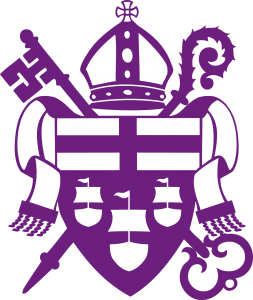Notes
- ↑ "The Church of England and the First World War" Wilkinson, A: Cambridge; Lutterworth; 2014 ISBN 978-0-7188-4165-2
- ↑ Anglican Church of Canada
- ↑ Crockford's Clerical Directory 1980–82 p604 London: OUP, 1983 ISBN 0-19-200010-1
A bishop's messenger was a woman appointed a lay reader by the Church of England during the First World War due to the shortage of male clergy. [1] Messengers were first appointed in 1917 in many dioceses of the Church of England.
Meanwhile, women were appointed to run missions, and in some cases church congregations. In the absence of men, however, many continued in their work after the war ended.
No further female lay readers were appointed until 1969. The women were organised into the Diocesan Order of Women Messengers (DOWM). The last bishop's messenger in England was Bessie Bangay, who died in 1987.
From 1928, bishop's messengers were also appointed in the Diocese of Rupert's Land. The first one was Marguerita Fowler (1884-1970), based at St. Faith's Church. [2]
This Welsh diocese also appointed clergymen to the post of Bishop's Messenger. [3]

The Anglican Communion is the third largest Christian communion after the Roman Catholic and Eastern Orthodox churches. Founded in 1867 in London, the communion has more than 85 million members within the Church of England and other autocephalous national and regional churches in full communion. The traditional origins of Anglican doctrine are summarised in the Thirty-nine Articles (1571). The Archbishop of Canterbury in England acts as a focus of unity, recognised as primus inter pares, but does not exercise authority in Anglican provinces outside of the Church of England. Most, but not all, member churches of the communion are the historic national or regional Anglican churches.

Anglicanism is a Western Christian tradition that has developed from the practices, liturgy, and identity of the Church of England following the English Reformation, in the context of the Protestant Reformation in Europe. It is one of the largest branches of Christianity, with around 110 million adherents worldwide as of 2001.

A bishop is an ordained member in a religious institution, who is entrusted with a position of authority and oversight.

The Church of England is the established national Christian church in England and the mother church of the international Anglican Communion. It traces its history to the Christian church recorded as existing in the Roman province of Britain by the 3rd century and to the 6th-century Gregorian mission to Kent led by Augustine of Canterbury.

The Nippon Sei Ko Kai, abbreviated as NSKK, or sometimes referred to in English as the Anglican Episcopal Church in Japan, is the national Christian church representing the Province of Japan within the Anglican Communion.

The Church in Wales is the Anglican church in Wales, composed of six dioceses.

The Anglican Church of Australia, formerly known as the Church of England in Australia, is a Christian church in Australia and an autonomous church of the Anglican Communion. It is the second largest church in Australia after the Roman Catholic Church. According to the 2016 census, 3.1 million Australians identify as Anglicans. According to a study published in 2016 by the Journal of Anglican Studies and Cambridge University Press, using the data contributed by the church, the Anglican Church of Australia has more than 3 million nominal members and 437,880 active baptised members. For much of Australian history the church was the largest religious denomination. It remains today one of the largest providers of social welfare services in Australia.

The Anglican Church of Canada is the province of the Anglican Communion in Canada. The official French-language name is l'Église anglicane du Canada. In 2017, the Anglican Church counted 359,030 members on parish rolls in 2,206 congregations, organized into 1,571 parishes. The 2011 Canadian Census counted 1,631,845 self-identified Anglicans, making the Anglican Church the third-largest Canadian church after the Catholic Church and the United Church of Canada. Although Canada has no established church, the Queen of Canada's Canadian Royal Style continues to include the title of Defender of the Faith, albeit not in relation to any specific denomination, and the Canadian Monarch continues her countenance of three Chapels Royal in the Realm.

In some Christian churches, a reader or lector is responsible for reading aloud excerpts of scripture at a liturgy. In early Christian times the reader was of particular value due to the rarity of literacy.
The history of the Anglican Communion may be attributed mainly to the worldwide spread of British culture associated with the British Empire. Among other things the Church of England spread around the world and, gradually developing autonomy in each region of the world, became the communion as it exists today.

A licensed lay minister (LLM) or lay reader is a person authorized by a bishop in the Anglican Communion to lead certain services of worship, to preach, and to carry out pastoral and teaching functions. They are formally trained and admitted to office, but they remain part of the laity, not of the clergy.

The Diocese of Virginia is the largest diocese of the Episcopal Church in the United States of America, encompassing 38 counties in the northern and central parts of the state of Virginia. The diocese was organized in 1785 and is one of the Episcopal Church's nine original dioceses, with origins in colonial Virginia. As of 2018, the diocese has 16 regions with 68,902 members and 180 congregations.

The Anglican ministry is both the leadership and agency of Christian service in the Anglican Communion. "Ministry" commonly refers to the office of ordained clergy: the threefold order of bishops, priests and deacons. More accurately, Anglican ministry includes many laypeople who devote themselves to the ministry of the church, either individually or in lower/assisting offices such as lector, acolyte, sub-deacon, Eucharistic minister, cantor, musicians, parish secretary or assistant, warden, vestry member, etc. Ultimately, all baptized members of the church are considered to partake in the ministry of the Body of Christ.

The history of the Episcopal Church in the United States of America has its origins in the Church of England, a church which stresses its continuity with the ancient Western church and claims to maintain apostolic succession. Its close links to the Crown led to its reorganization on an independent basis in the 1780s. In the nineteenth and early twentieth centuries, it was characterized sociologically by a disproportionately large number of high status Americans as well as English immigrants; for example, more than a quarter of all presidents of the United States have been Episcopalians. Although it was not among the leading participants of the abolitionist movement in the early 19th century, by the early 20th century its social engagement had increased to the point that it was an important participant in the Social Gospel movement, though it never provided much support for the Prohibitionist movement. Like other mainline churches in the United States, its membership decreased from the 1960s. This was also a period in which the church took a more open attitude on the role of women and toward homosexuality, while engaging in liturgical revision parallel to that of the Roman Catholic Church in the post Vatican II era.

The United Episcopal Church of North America (UECNA) is a church in the Anglican tradition and is part of the Continuing Anglican movement. It is not part of the Anglican Communion.

The Episcopal Church (TEC), based in the United States with additional dioceses elsewhere, is a member church of the worldwide Anglican Communion. It is a mainline Protestant denomination and is divided into nine provinces. The presiding bishop of the Episcopal Church is Michael Bruce Curry, the first African-American bishop to serve in that position.
The Episcopal/Anglican Province of Alexandria is a province of the Anglican Communion. Its territory was formerly the Diocese of Egypt with North Africa and the Horn of Africa. On 29 June 2020 the diocese was elevated to the status of an ecclesiastical province, and became the forty-first province of the Anglican Communion. The primate and metropolitan of the province is the archbishop of Alexandria.

The ordination of women in the Anglican Communion has been increasingly common in certain provinces since the 1970s. Several provinces, however, and certain dioceses within otherwise ordaining provinces, continue to ordain only men. Disputes over the ordination of women have contributed to the establishment and growth of progressive tendencies, such the Anglican realignment and Continuing Anglican movements.
Ruth Elizabeth Worsley, is a Church of England bishop. Since September 2015, she has been the Bishop of Taunton, a suffragan bishop of the Diocese of Bath and Wells. From 2013 to 2015, she was Archdeacon of Wiltshire.

Marion Macfarlane was the first woman to be ordained in the Anglican Church in Australia. She was ordained to the "Female Diaconate" in 1884 in the Diocese of Melbourne, then in 1886 converted to Catholicism, took the name Sister Mary Euphrasia, and joined the Sisters of the Good Shepherd.